|

Brakas - A mischievous monkey-like creature. This creature is only found in Le-Wahi.

Daikau - A carnivorous plant. The Daikau is a jungle-faring being, only a Rahi because of its 'dumb' sentience and
ability to think. It is found sporadically around Mata Nui but mostly in the jungles of Le-Wahi.

Dikapi - The Dikapi is a hardy desert bird with a strong beak and a distinctive flute-like whistle. Although it cannot
fly, it can run for hours upon end without stopping for food or rest. Some Dikapi have been trained by the Matoran of Po-Koro
to carry scouts and messengers quickly across the sands.

Fikou - The Fikou is a dangerous tree spider found in the jungles of Mata Nui. It is most often seen in the vicinity
of Le-Koro, and the Le-Koro Matoran must always be on guard when swinging through the trees. The Fikou are dangerous when
threatened, no matter the size. These vicious spiders love to lurk around the high branches and wait for their incredibly
strong webs to entangle prey.

Fusa - The Fusa resemble kangaroos, and are known for their powerful hind legs. Fusa are most often found near Po-Koro
and along the eastern coast of Mata Nui, and are relatively harmless unless provoked. Their natural enemies include the Muaka
and the Takea.

Ghekula - The Ghekula is an amphibious creature found in the swamps beneath Le-Koro on the island of Mata Nui. During
the he activities of the Bohrok have forced the Ghekula to migrate, and many of them are seeking the calmer waters near Ga-Koro,
although most are returning or have returned since the Bohrok's defeat. The Ghekula are regarded highly by the Matoran, and
it is considered bad luck to hurt one.

Goko-Kahu - Also called the Kewa, the Goko-Kahu are vultures who are much prized by the Le-Koro Matoran. The Matoran
have managed to tame many of these birds and train them to come in response to the playing of a flute. The Kewa are very popular
among the Le-Matoran. Many Matoran use a flute to call these birds, and they can fly the Matoran to many other Koros.

Graalok - An ash-bear Rahi that dwells in Le-Wahi. This Rahi is a fierce creature found in the jungle of Le-Wahi. The
Ash Bear used to be imprisoned by Makuta, but luckily Lewa saved most of them after the Makuta was defeated for the first
time from the infected mask's power.

Gukko - A large and dependable bird of Le-Koro often used for riding. The Gukko are large birds that dwell in Le-Wahi.
Related to the slightly smaller Goko-Kahu, or Kewa as they are often called, who in turn are closely related to the even smaller
Taku. The Gukko are often tamed for flying in the Le-Matoran Gukko Patrol, and now that Makuta has relinquished control over
the Rahi, they even use some Nui-Rama for substitutes.

Hapaka - Hapaka are native to the mountainous regions of Mata Nui, where they bound from rock to rock with sure-footed
ease. Natural herders with a sharp, barking cry, they are often trained to guard Po-Koro's precious Mahi and Husi flocks.
They are friendly and curious creatures that make loyal pets and companions.

Hikaki - The Hikaki is a small creature resembling a dragon, and is a native of the region surrounding the Mangai Volcano.
They seem to thrive amidst the molten lava, and there is an old Matoran legend that the Hikaki actually feed off the fire.
As with many other creatures of Mata Nui, the Hikaki is dangerous mainly when its nest is disturbed.

Hoi - The Hoi are flying swamp turtles that dwell in the vicinity of Le-Koro. They are slow and relatively harmless.
The arrival of the Lehvak forced many of the Hoi to move into coastal waters, where they have had a harder time surviving.
Gali and the Ga-Koro Matoran have made an extra effort to aid and protect the Hoi.

Hoto - The Hoto are firebugs who reside in the Ta-Koro region. Though quite small, their habit of tunneling using the
sheer, searing heat given off by their bodies has resulted in rockslides and collapses of some Matoran structures. They are
regarded as a pest.

Husi - The Husi is a large bird resembling an ostrich. Though it can be dangerous (it has a habit of pecking), the
Husi is more often tamed and traded at bazaars in return for goods and services. Husi spend their time among the rocky crags
of Po-Koro.
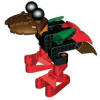
Infernavika - This tiny bird makes its home among the molten lava near Ta-Koro. Living in the midst of lava helps the
infernavika survive, as there are few predators that will venture too near an active volcano.

Kane-Ra & Muaka - Muaka and Kane-Ra are two specific names for these Rahi. Muaka is a tiger-like Rahi where Kane-Ra
is like a great bull. They usually work together, and when they do, watch out! They make a huge and powerful team.

Kavinika - These wolf-like creatures were originally intended as guards for low-priority facilities. Unfortunately,
their nature was such that they would fight each other, Ussal crabs and other Rahi, and even threatened their Matoran masters.
As a result, efforts have been made to drive them out of the city although with limited success so far.

Keras - The Keras coral crab is a reclusive reef-dwelling creature, famed for protecting its undersea home with great
ferocity. The Gahlok have driven a number of Keras onto the beaches of Mata Nui, and volunteers from the Onu-Matoran Ussalry
have helped the villagers of Ga-Koro to tame a few as partners in the struggle against the Bohrok swarms. Outfitted with special
riding plates, these fierce and clever crabs can carry riders across both sea and land. They contentedly serve as defenders
of the village in exchange for shelter from the sun and a meal of fresh fish.

Kikanalo - Kikanalo are massive creatures resembling a cross between a kangaroo and an elephant. When night falls on
the Sculpture Fields and the carvers go home for the night, herds of wild Kikanalo sweep across the Fields digging up left-over
scraps of stone-protodermis from carving for later recycling by the Matoran. Their usefulness explains how they can get away
with stampeding—and crushing—a few Assembler’s Villages. You don’t want to get in the way while they’re
working.
Toa Nokama has communicated with these animals before using her Kanohi Rau, Great Mask of Translation.

Kinloka - Although this creature resembles an insect, it is in fact a particularly vicious form of a large rodent.
A distant relative of the stone rats of Onu-Metru, this creature seems to be the result of an experiment to produce an animal
with a more efficient digestive system. The unfortunate result was a nasty beast that is always hungry, and will devour anything
in its path. They commonly carry disks with the weaken power too slow down opponents.
Long ago, the Kinloka accessed a vault of Kanoka Disks. Over time, they have learned how to use them, and that is how they
ended up with them.

Kirikori Nui - It is said that in an age long past, the wings of the Kirikori Nui darkened the skies of Mata Nui and
their ringing call drowned out all other sounds. Today, the great insects are rare and spend their lives browsing at the edge
of the Po-Wahi desert. Despite their scythe-like jaws and powerful legs, Kirikori Nui avoid confrontation, bounding incredible
distances away from even the slightest of disturbances. The Turaga remember the legends, however, and keep a watchful eye
on the skies.

Kofo-Jaga - The Kofo-Jaga are small in size, but great in the potential danger they pose to the unwary. Kofo Jaga are
found most often in the vicinity of Onu-Koro, but it is believed they may have migrated there from the Ta-Koro area at some
time in the distant past. They are small in size, but great in the potential danger they pose to the unwary, especially in
swarms. An old Matoran tale tells of how a swarm of fire-scorpions felled a full-grown Kane-Ra. Once, a large swarm made two
Manas back away!
Kofo-Jaga are found most often in the vicinity of Onu-Koro, but it is believed they may have migrated there from Ta-Wahi at
some time in the distant past. Kofo-Jaga often glow with heat, and they are attracted to any kind of heat source, such as
lava. Once they reach a hot spot, they will stop and defend it ferociously. When they were infected, the fire-scorpions moved
and attacked whenever Makuta wished them. But now they are free, they only move if they smell lava, and attack only if their
nests or swarms are disturbed. Kofo-Jaga are immune to even molten lava, but curiously, they hate bright light. Having a Lightstone
and a disc is useful if you encounter one of these within the tunnels, but just run if you find a swarm.

Kraawa - At first glance, this Rahi does not seem particularly frightening or dangerous. Yet it is held in the most
secure section of the Onu-Metru Archives and any and all contact with it is strictly forbidden. Apparently, its defense against
predators is its ability to absorb any force used against it and use that energy to grow. Matoran are unsure whether any other
specimens exist, but they sincerely hope they do not.
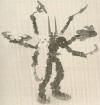
Krahka - Deep underground, below the Archives, exists a Rahi with extraordinary powers: the ability to copy the appearance,
powers and voice of anything she comes in contact with. Krahka lives in the maintenance tunnels of Archives, along with Rahkshi,
Lava Eels and other dangerous creatures. The Toa Metru once challenged this creature, and nearly lost.

Kuma-Nui - A giant rat Rahi.

Kuna - These bog snakes are found most often in the vicinity of Le-Koro. They are natural enemies to the Ghekula and
other small reptiles and amphibians that live in the swamps.

Lightfish - Small, glowing Rahi that dwell in the waters of Mata Nui. They are often used to light Ga-Matoran huts
on Mata Nui.

Mahi - A horned, goat-like Rahi.

Makika - The Makika are large, highly dangerous toad-like creatures who dwell in the caves near Po-Koro. Makika rarely
venture out of their caves, but will defend their territory against any intruders. They are prized by Matoran for their acidic
venom, which is of great use when mining or tunneling through stone.

Mana-Ko - A legendary creature, believed to be the ultimate guardian of the Makuta.
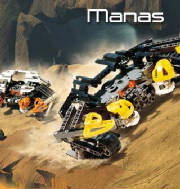
Manas - The Manas are huge crab-like Rahi and are well known for being the defenders of Makuta's lair. Manas can be
defeated if their infected masks are taken off. They are still quite a mysterious species of Rahi, though.
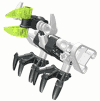
Mata Nui Fishing Bird - The clever and noisy Mata Nui Fishing Birds live in the lower branches of the Le-Wahi jungle.
They have keen eyesight and delight in swooping just out of reach of hungry Rahi, taunting them with mocking squawks and screeches.
They are skilled at diving for fish and often flock to the sea, where they merrily splash and chatter in the sparkling waves.

Mukau - The Mukau is a placid animal that lives in herds on the plains of Mata Nui. Although peaceful by nature, it
is quick to react to danger. Opponents would be wise to beware the Mukau's horns and hooves, which it can wield with surprising
speed.
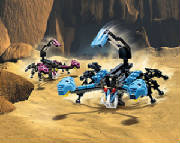
Nui-Jaga - The Nui-Jaga mostly resemble massive scorpians that rush about on the jungle floor. Their huge snapping
stingers close down on their victims with surprise. If they are departed from their infected masks, though, they will be tamed.

Nui-Kopen - A huge wasp-like Rahi.
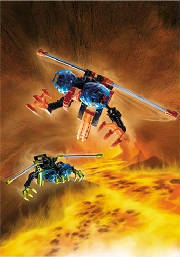
Nui-Rama - Flying high above the island of Mata Nui, the Nui-Rama are huge insect-like Rahi that infest the skies.
They make their nests in the jungles of Le-Koro, and most of the time they are hunting down Makuta's enemies. When their infected
masks are taken away, they are tamed.

Powaki - The Pokawi jungle fowl is a small, flightless bird of Le-Wahi with a loud 'pok-pok-pok' call. Pokawi spend
their entire lives on the marshy jungle floor, hunting for edible insects and fallen fruits or seeds. When a flock of Pokawi
is surprised by a Rahi, each hops away in a different direction, creating a bewildering explosion of sound and color that
confuses the predator and helps the birds to escape.

Ranama - The giant Ranama thrives in the heat of Ta-Wahi, where it swims through the lava flow as if it were water.
Lurking beneath the molten surface, a hungry Ranama will wait for an unwary Nui-Rama to fly past, then leap forth with an
enormous fiery splash to ensnare the insect with its long and sticky tongue. Most Matoran know better than to approach the
hissing, steaming amphibians, which will eat just about anything that they can catch.

Ruki - The Ruki is a fish that can be found all along the coast of Mata Nui. It is known for its powerful, snapping
jaws and habit of chewing through Matoran fishing nets. Although much smaller, the Ruki are a natural enemy of the Tarakava,
and schools of them have been known to drive the Rahi off.
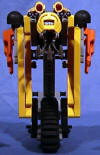
Sand Tarakava - A desert-dwelling breed of Tarakava. Unlike it's water-bred cousin, the Sand Tarakava dwells in the
barren deserts of Po-Wahi with the Nui-Jaga. The Sand Tarakava is slightly smaller than it's cousins.

Takea - Before Makuta infected the powerful Tarakava and sent them against the Matoran, the Takea were considered to
be the most dangerous creatures in the sea. Dubbed the "king of sharks," just the rumor of a Takea in the water is enough
to send the Matoran of Ga-Koro scrambling to shore.

Taku - The Taku is a close relative of the Goko-Kahu, though a much smaller bird. Unlike its scavenging cousin, the
Taku is aquatic, capable of diving to great depths to catch fish.

Tarakava - Tarakava are the monsters of the water on Mata Nui, swimming in the rivers and oceans surrounding the island.
They usually travel and fight as two, in pairs. But just like all Rahi, when seperated from their infected masks, they are
tottally controlable.

Tarakava Nui - The King of Lizards, a giant Rahi that strikes from ambush.

Ussal - The Ussal are crabs known for their ability to tunnel. The Matoran of Onu-Koro use them for transport and for
sport - Ussal crab racing is one of the best-loved competitions in the village. The Ussalry is a mounted defense force for
Onu-Koro, featuring Matoran riding on Ussal crabs.

Vako - This great horned beast roams the plains of Mata Nui in herds. Even the Rahi steer clear of the Vako, who are
capable of charging at great speeds. The Po-Koro Matoran have attempted to tame the Vako a few times, but without success.
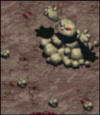
Vatuka - An elemental rock creature. The Vatuka is a very mysterious creature. It lives in the darkness of Onu-Wahi,
and Whenua, on his way to inspect some tunnels, was once captured by this creature. Takua saved him later on.
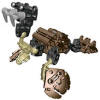
Waikiru - The Waikiru is swift and agile in the water, but clumsy and slow-moving on land. Waikiru live and feed in
groups, using their sturdy tusks to drive away Takea and other aquatic predators. They are not dangerous if treated with care,
but they are quick to react to threats by charging or swimming away.
|